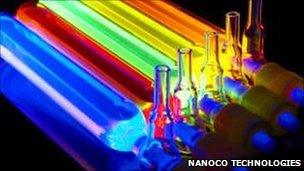UEA scientists harness sun's power to make clean fuels
- Published

Scientists at UEA are harvesting light energy using quantum dots
Scientists from the University of East Anglia (UEA) in Norwich are working on harnessing the energy of the sun to make clean fuels.
Collaborating with the universities of Manchester, York and Nottingham, they are using nanotechnology 100,000 times smaller than the width of a human hair.
They believe their work could help ease the world's energy crisis.
The scientists are presenting their research at the Royal Society's summer science exhibition in London.
Prof Chris Pickett of UEA's School of Chemistry said: "Creating catalytic devices which harvest light energy using quantum dots, or photovoltaic materials to drive the formation of synthetic fuels from water or carbon dioxide can be viewed as artificial photosynthesis."
Quantum dots
He added: "Globally, chemists, physicists and materials scientists are coming together to work on artificial photosynthesis to get to a stage where we can viably make clean, green fuels."
Prof Wendy Flavell, from the University of Manchester's Photon Science Institute, and her colleagues are working to create a solar-nano device using "quantum dots" - tiny clusters of semi-conducting material which absorb sunlight.
When sunlight is absorbed, carriers of electric current are created.
Together with catalyst molecules grafted to the surfaces of the dots, these create the new fuel - for example the production of hydrogen from water.
Prof Flavell said: "Our sun provides far more energy than we will ever need, but we use it really inefficiently."
She added: "To make better use of the fantastic resource we have in our sun, we need to find out how to create solar fuel that can be stored and shipped to where it is needed and used on demand."
- Published6 May 2011
- Published20 April 2011
- Published24 January 2011